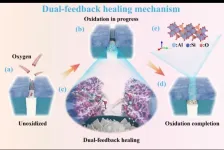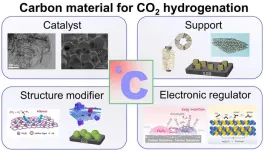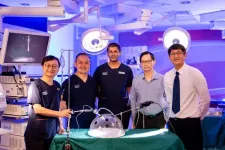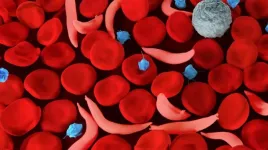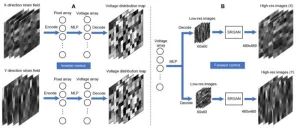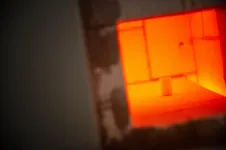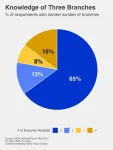Fiber-reinforced ceramic matrix composites (CMCs) have been the primary choice for radome materials in hypersonic vehicles due to their high toughness, strength, and other advantageous properties. However, oxidation by oxygen in the atmospheric environment at elevated temperatures remains a significant obstacle to their further development. Thermal protection coatings offer a crucial avenue to mitigate this issue. Nonetheless, inherent material differences or fiber orientations within CMCs can lead to disparate thermal expansion rates between the matrix and fibers during temperature variations, inevitably generating internal stresses. These internal stresses, ironically, contribute to the cracking and even detachment of coatings, posing a challenge to their effectiveness.
"The way of the Tao moves through opposition; its function is found in what is weak." Inspired by the wisdom of ancient philosophers, Professor Xia Long from the Key Laboratory of Special Ceramic Design and Preparation at Harbin Institute of Technology (Weihai) has proposed a conceptual framework rooted in reverse thinking to address this issue, attempting to achieve a higher "return" through a minimal "sacrifice." Recognizing the inherent difficulty in preventing coating cracks, the team suggests harnessing oxidation at the crack sites, where the resulting oxide products can chemically or physically interact with the oxidation-resistant coating to reduce material viscosity. This targeted self-healing of thermally mismatched cracks is named the "Dual-feedback self-healing mechanism."
The team published their work in Journal of Advanced Ceramics on September 5, 2024.
In the article, the SOAC@BNf/SiBN composite material was fabricated to validate the proposed design. The SOAC layer was produced using a multi-step spray coating process. The organic-to-inorganic transformation process of SOAC was examined across various sintering temperatures, confirming that no crystalline structures were formed during the transition from the organic coating to the inorganic coating. This finding underscores the notable advantage of the coating in effectively adhering to the substrate surface.
Validation through oxidation tests on BNf/SiBN ceramics revealed that the BNf/SiBN composite initiates gradual oxidation near 1100°C. During this process, the generated B2O3 vapor, upon escape, reacts with SiO2 in the Si-O-Al system to form SiO2-B2O3 glassy phase. This reduces the viscosity of the oxidation-resistant coating, enabling it to spontaneously flow and fill defects, thus sealing off oxygen penetration pathways. Consequently, the coating effectively safeguards the substrate at elevated temperatures.
Thermal analysis results demonstrate a significant reduction in the high-temperature oxidation weight loss rate of the Si-O-Al@BNf/SiBN material system, from 11% to 2.4%. This is attributed to the dual-feedback self-healing mechanism, which safeguards the structural integrity and preserves the mechanical properties of the material in high-temperature environments.
However, further meticulous research is necessary to delve into the theoretical feasibility of the dual-feedback self-healing mechanism. Xia also suggests that future endeavors may explore materials with enhanced chemical or physical interactions between the matrix oxidation products and protective coatings, aiming to improve the high-temperature oxidation resistance of fiber composites.
Other contributing authors include Yuanshuai Wang, Xinyu Wang, Pianpian Zhang, Anqi Lun, Yuewei Li, Yi Wang, Lizhe Xing, Zhengyang Fu, and Ya'nan Yang, all affiliated with Harbin Institute of Technology (Weihai).
This work was supported by the National Natural Science Foundation of China (Grant No 51972078), the Heilongjiang Touyan Team Program, the Fundamental Research Funds for the Central Universities (Grant No. HIT. OCEF. 2021003) and the Key Laboratory of Advanced Structural-Functional Integration Materials & Green Manufacturing Technology.
About Author
Xia Long holds a Ph.D. in Engineering from Harbin Institute of Technology (HIT), where he currently serves as a Professor, Doctoral Supervisor, and Deputy Dean of the School of Materials Science and Engineering at HIT (Weihai). He is also an Executive Director of Shandong Composite Materials Society and a Communication Review Expert for the National Natural Science Foundation of China. Recognized for his achievements, Xia has been selected for the "University-Region Cooperation" Talent Program and has received the First Prize of Heilongjiang Provincial Natural Science Award and the Second Prize of Provincial Technological Invention Award.
Xia serves as an Editorial Board Member of the Journal of Advanced Ceramics and an Expert Reviewer for Degree Theses of the Ministry of Education. His primary research interests lie in the fundamental and applied studies of ceramic matrix composites for thermal structures and radar-absorbing stealth applications. He has presided over projects funded by the National Natural Science Foundation of China (including Youth and General Programs) and supporting projects from the State Administration of Science, Technology, and Industry for National Defense. Xia has published over 70 research articles in prestigious international journals such as Acta Materialia and Carbon, of which 4 are highly cited, as the first author or corresponding author. He holds 12 authorized national invention patents and has co-authored the national "13th Five-Year" planning textbook "Special Ceramic Materials."
About Journal of Advanced Ceramics
Journal of Advanced Ceramics (JAC) is an international academic journal that presents the state-of-the-art results of theoretical and experimental studies on the processing, structure, and properties of advanced ceramics and ceramic-based composites. JAC is Fully Open Access, monthly published by Tsinghua University Press, and exclusively available via SciOpen. JAC’s 2023 IF is 18.6, ranking in Top 1 (1/31, Q1) among all journals in “Materials Science, Ceramics” category, and its 2023 CiteScore is 21.0 (top 5%) in Scopus database. ResearchGate homepage: https://www.researchgate.net/journal/Journal-of-Advanced-Ceramics-2227-8508
About SciOpen
SciOpen is an open access resource of scientific and technical content published by Tsinghua University Press and its publishing partners. SciOpen provides end-to-end services across manuscript submission, peer review, content hosting, analytics, identity management, and expert advice to ensure each journal’s development. By digitalizing the publishing process, SciOpen widens the reach, deepens the impact, and accelerates the exchange of ideas.
END
